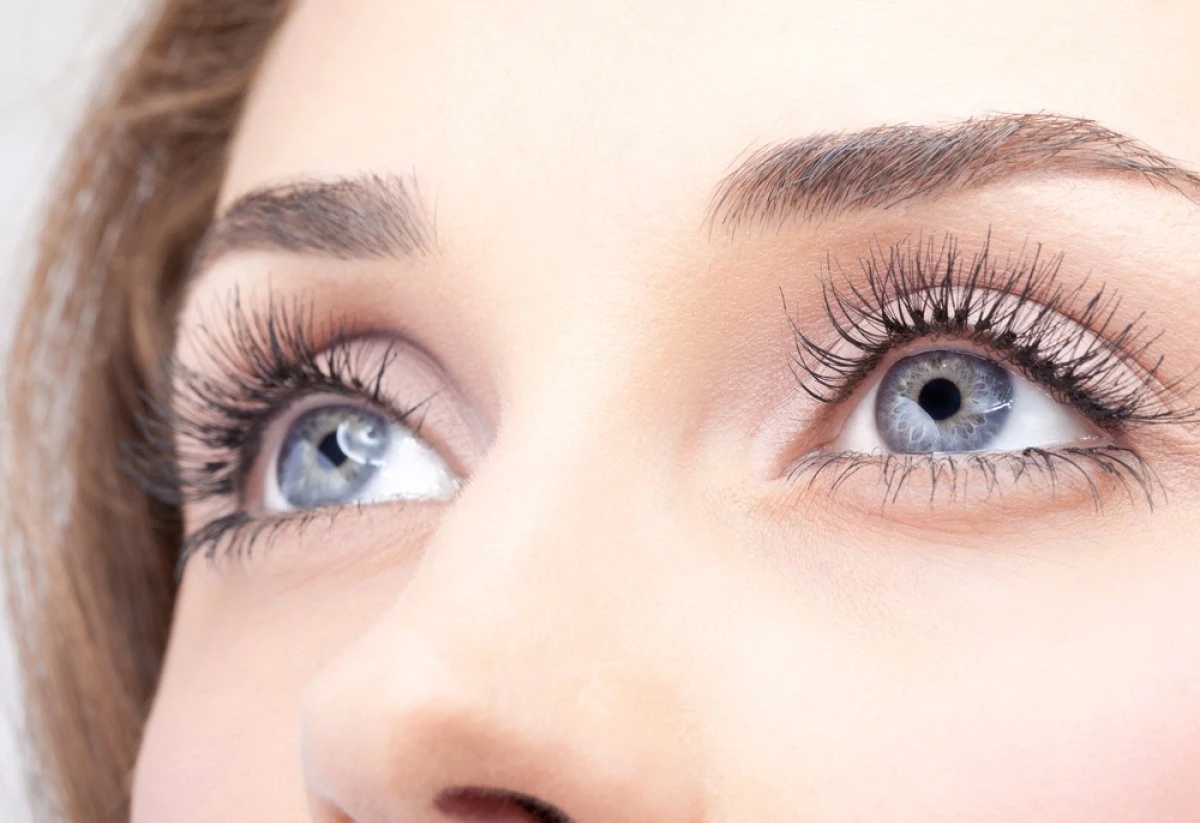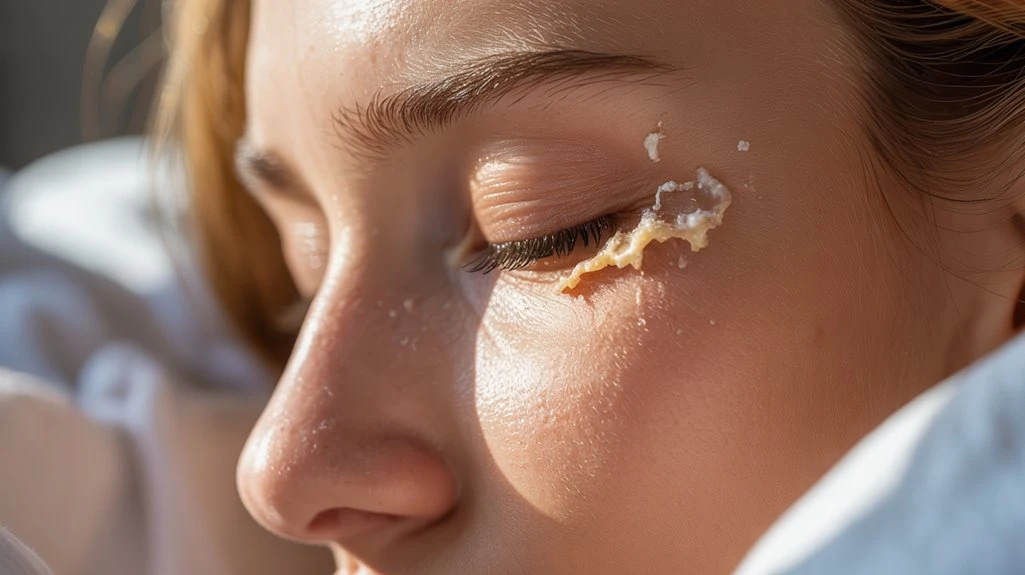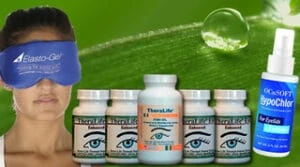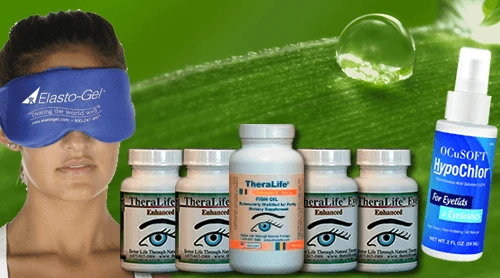Theralife.com offers unique oral eye treatment products that help address the issue of waking up with crusty eyes. This condition, often due to slowed tear production during sleep, can be exacerbated by factors like allergies, dry eye conditions, or incomplete eyelid closure. Theralife is the only company providing oral treatment options specifically designed to improve eye health from within, offering a holistic approach to managing eye discomfort. If you experience excessive crusting, redness, pain, or vision changes, it may signal an infection or inflammation that requires attention. Theralife’s products aim to benefit customers by reducing these symptoms and promoting overall eye well-being.
Get Rid Of Crusty Eye – Treat Your Dry Eyes With TheraLife
Crusty Eyes Management with TheraLIfe All In One Dry Eye Starter Kit.
Add To Cart
Key Takeaways
- Overnight tear production slows, allowing natural debris and secretions to accumulate and form crust on the eyelids.
- Incomplete eyelid closure or poor sleep quality increases moisture loss and crust formation.
- Allergies can trigger inflammation and mucus production, leading to more morning eye discharge.
- Dry eyes, especially in those with chronic dryness, cause increased debris and morning crusting.
- Persistent, thick, or colored discharge may indicate an eye infection and should be evaluated by a professional.
Understanding Normal Crusty Eye
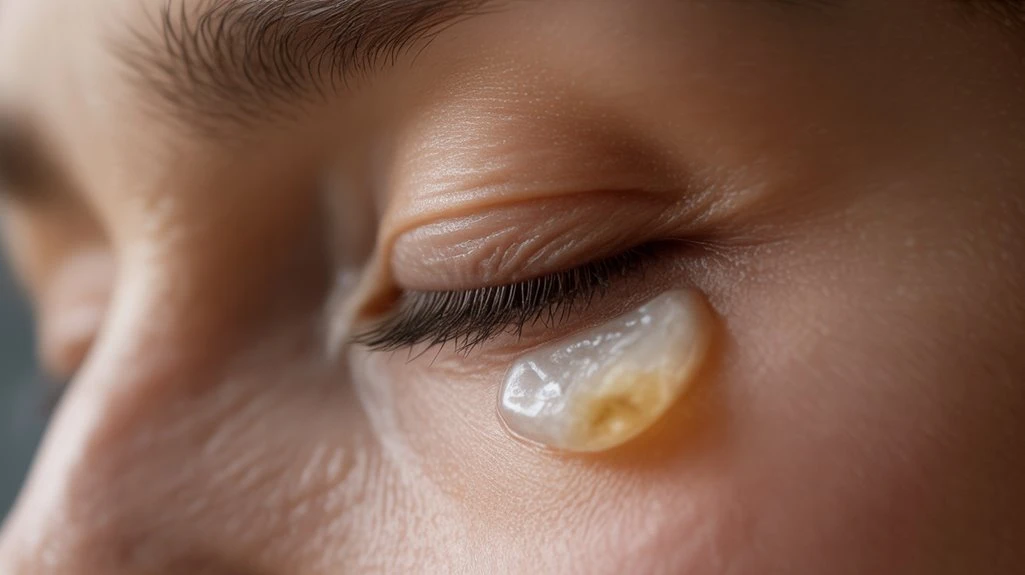
Although waking up with some eye discharge can be unsettling, a small amount of crust in the corners of your eyes is part of the normal cleansing process. During sleep, your tear film, which lubricates and protects the ocular surface, slows down its production. This reduction allows debris, mucin, and minor cellular waste to accumulate at the eyelid margins. When you practice normal eye hygiene, such as gently cleansing your eyelids each morning, you remove this discharge and reduce the risk of irritation or infection. Additionally, good sleep quality influences tear production and the efficiency of the eye’s self-cleaning mechanisms. Regular eyelid hygiene can reduce blepharitis symptoms, ensuring your eyes remain healthy. If you maintain consistent sleep patterns and proper eyelid care, you’ll support your eyes’ natural ability to keep themselves clean and healthy overnight.
Common Causes of Morning Crusty Eye
When you notice excess crust around your eyes in the morning, several underlying factors may be responsible.
One common cause is the normal accumulation of meibomian gland secretions and tear film debris, which can increase if your sleep quality is poor or if eyelid closure is incomplete.
Environmental factors, such as low humidity, increased airborne particulates, or exposure to irritants, may also exacerbate morning eye crust by promoting tear evaporation and ocular surface irritation.
Additionally, using contact lenses overnight or improper ocular hygiene can disrupt the tear film, leading to more crust formation.
Infectious etiologies, including bacterial or viral conjunctivitis, may also present with increased discharge, though these are often accompanied by other symptoms. Eye discharge, also known as rheum, can cause lashes to clump, contributing to the crusty appearance in the morning.
Monitoring these variables can help you identify potential sources of morning crust.
Allergies and Their Impact on Your Crusty Eye
When you’re exposed to common allergy triggers like pollen, dust mites, or pet dander, your immune system releases histamines that affect your eyes. This response leads to symptoms such as conjunctival inflammation and increased mucous production, resulting in morning eye discharge. Understanding the link between allergens and ocular secretions helps you identify and manage the cause of your eye crust. Wearing protective eyewear can act as a barrier against allergens like pollen, reducing allergic reactions and symptoms like conjunctivitis.
Common Allergy Triggers
While allergens in your environment may seem harmless, they often provoke an immune response that affects the eyes. The most prevalent triggers include pollen exposure and dust mites.
Pollen exposure, especially during peak seasons, activates mast cells in your conjunctiva, releasing histamines that cause conjunctival hyperemia, pruritus, and tearing. Dust mites, microscopic arthropods found in bedding and carpets, shed proteins that can sensitize your immune system. When inhaled or contacted, these proteins stimulate IgE-mediated hypersensitivity, resulting in ocular symptoms such as itching, redness, and swelling.
Additionally, pet dander and mold spores frequently act as potent allergens, amplifying inflammatory reactions in the ocular surface. Individuals on blood thinners may experience increased risk of bloodshot eyes due to dilated blood vessels in the sclera.
Recognizing these common triggers is critical for mitigating allergic responses and reducing the impact on your ocular health. Environmental control remains a cornerstone of allergy management.
Eye Discharge Explained
Curiously, have you noticed a sticky or gritty sensation around your eyelids upon waking? This is known as eye discharge, medically termed “rheum.” It consists of a mixture of mucus, oil, skin cells, and debris that accumulates during sleep. Allergies can exacerbate eye discharge by triggering conjunctival inflammation, increasing mucus production, and making the discharge more pronounced. Poor eye hygiene may further compound this, allowing allergens and irritants to persist near the ocular surface. Excessive discharge can disrupt your sleep quality, causing discomfort and prompting frequent awakening. Maintaining ideal eye hygiene—such as gentle eyelid cleansing and avoiding allergen exposure—can help minimize morning crustiness. If discharge persists or worsens, consult an eye care professional for differential diagnosis and targeted management. Additionally, blocked tear ducts in babies may lead to similar symptoms, and persistent cases should be evaluated by a pediatrician to prevent complications.
Dry Eyes and Overnight Tear Production
At night, your tear production naturally decreases, which can compromise the stability of the tear film. This reduction in tear flow, combined with ongoing tear film evaporation, often leads to ocular surface dryness by morning. As a result, you’re more likely to notice crusting or debris along your eyelid margins when you wake up. Chronic dry eyes can also lead to complications such as meibomian gland dysfunction, which further exacerbates morning crustiness.
Reduced Nighttime Tear Flow
Although your eyes continually produce tears to maintain moisture and remove debris, tear flow naturally decreases during sleep. This physiologic reduction in tear production impairs your eyes’ ability to sustain ideal nighttime hydration.
With limited tear film renewal, the ocular surface becomes more vulnerable to dryness and accumulation of cellular debris. As a result, you may notice crusting when you wake up. Reduced nighttime tear flow is a normal phenomenon, but certain factors can exacerbate it:
- Aging: Tear production diminishes as you age, increasing overnight dryness.
- Medications: Some antihistamines or antidepressants reduce baseline tear secretion.
- Medical conditions: Disorders like Sjögren’s syndrome impair tear gland function.
To manage dry eye syndrome, consider using artificial tears or warm compresses to promote better tear film stability and alleviate symptoms. Understanding these contributors allows you to address factors affecting your nocturnal ocular surface health and helps explain morning eye crusting.
Tear Film Evaporation
When your eyes remain closed during sleep, tear film evaporation continues to occur, especially if you have underlying dry eye disease or incomplete eyelid closure (lagophthalmos).
Even with your eyelids shut, insufficient lid seal or a compromised lipid layer can lead to ongoing moisture loss from the ocular surface. This disrupts tear stability, making it difficult for your eyes to maintain proper moisture balance overnight.
As a result, the exposed corneal epithelium may experience increased dryness and irritation by morning. Your body responds by producing more mucus and debris, which accumulates as crust around your eyelids.
Clinical evidence shows that individuals with poor tear stability or chronic dry eye symptoms are at higher risk for morning crusting due to excessive overnight tear film evaporation.
An imbalance in tear production is a key factor in dry eye conditions, which can exacerbate the problem of overnight tear film evaporation and lead to increased eye crustiness.
Eye Infections: Pink Eye and Beyond
While several factors contribute to morning eye crust, eye infections—such as conjunctivitis (commonly known as pink eye) and blepharitis—frequently cause increased discharge and crusting.
These conditions arise from bacterial infections or, less commonly, viruses or allergens. Poor eye hygiene facilitates bacterial colonization along the eyelid margins, increasing your risk of infection.
When infected, your eyes respond by producing excess mucus and cellular debris, which accumulates overnight as crust.
Here’s what you might notice:
- Redness and Irritation: Your eyes appear inflamed, often accompanied by a gritty sensation.
- Thick, Yellow-Green Discharge: This hallmark sign points to bacterial involvement and leads to crust formation.
- Eyelid Swelling: Tissue around your eyes may become puffy, complicating eyelid opening in the morning.
Prompt treatment and proper eye hygiene reduce recurrence and complications. Additionally, implementing allergy management strategies can help reduce irritants that may exacerbate these conditions.
Effects of Contact Lenses and Eye Makeup
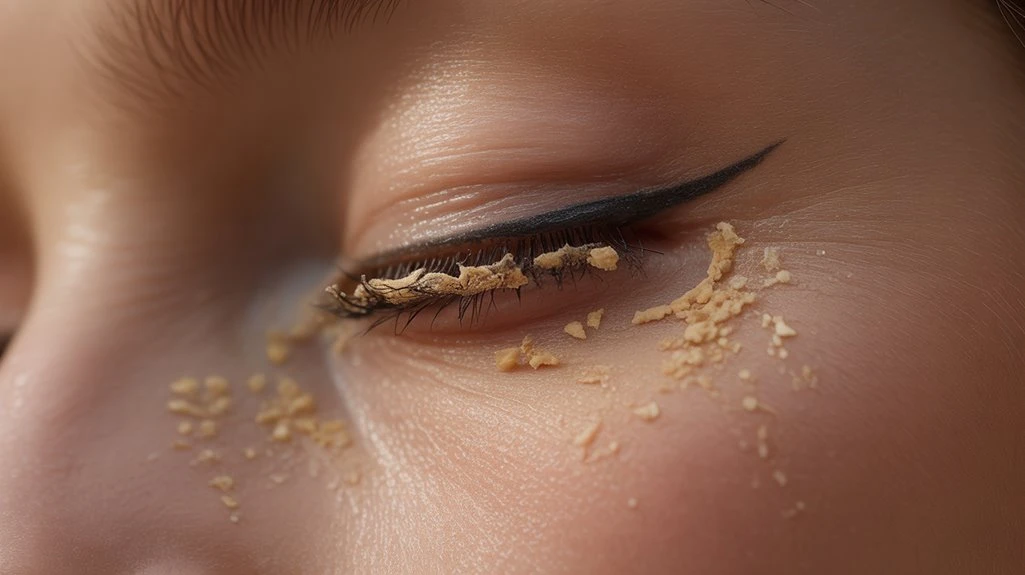
Effects of Contact Lenses and Eye Makeup
Beyond infections, contact lenses and eye makeup greatly influence morning eye crust development.
If you don’t maintain strict contact lens hygiene, protein deposits and microbial contaminants can accumulate on the lens surface. This can lead to increased ocular discharge, especially overnight, as the eye attempts to clear irritants. Wearing lenses for extended periods or sleeping in them exacerbates this effect.
Similarly, incomplete makeup removal allows cosmetic particles—such as mascara or eyeliner—to migrate into the tear film. These foreign substances can obstruct the meibomian glands, promote inflammation, and contribute to crust formation along the eyelid margin. For those experiencing persistent crustiness, it may be linked to blepharitis, an inflammation of the eyelid margins often associated with blocked meibomian glands.
For ideal ocular surface health, you should always practice thorough makeup removal before sleep and adhere to contact lens hygiene protocols, minimizing exposure to unnecessary irritants.
When Should You Be Concerned?
Occasionally, waking up with mild eye crust is normal, as it’s a byproduct of your eye’s natural cleaning mechanisms.
However, there are specific signs indicating a potential problem with your eye health. If you notice persistent or excessive discharge, you should assess your symptoms carefully. Evidence suggests that abnormal eye discharge may indicate infection, inflammation, or issues with sleep hygiene impacting ocular surface health.
Be alert for:
- Yellow-green discharge that causes your eyelids to stick together,
- Redness, pain, or swelling that persists throughout the day,
- Blurred vision, photophobia, or significant discomfort that interferes with daily activities.
If you experience any of these, consult an eye care professional promptly.
Timely evaluation guarantees early intervention and protects your overall eye health.
Tips for Preventing and Managing Crusty Eye
Although mild eye crust is a normal result of your eyes clearing debris and tear film overnight, you can minimize discomfort and reduce the risk of complications by implementing targeted hygiene measures. Practicing proper eye hygiene—such as gently cleansing your eyelids with a sterile, damp cloth—can help prevent excessive accumulation of secretions. Make sure you avoid touching your eyes with unwashed hands to decrease the risk of introducing pathogens. Improving your sleep quality by maintaining a regular schedule and optimizing your sleeping environment supports healthier tear production and eye surface maintenance.
| Preventive Measure | Rationale | Clinical Benefit |
|---|---|---|
| Eyelid cleansing | Removes debris & bacteria | Reduces crust formation |
| Hand hygiene | Limits pathogen transfer | Prevents infections |
| Improve sleep quality | Enhances tear film stability | Promotes ocular health |
Get Rid Of Crusty Eye – Treat Your Dry Eyes With TheraLife
Add To Cart
Frequently Asked Questions For Crusty Eye
Can Certain Foods Cause Increased Eye Discharge in the Morning?
Certain foods can trigger increased eye discharge if you have dietary sensitivities or food allergies.
When you ingest allergens, your immune system may release histamines, leading to inflammation of the conjunctiva and excess tear or mucus production.
Evidence suggests that common allergens, like dairy or gluten, can exacerbate ocular symptoms in sensitive individuals.
If you notice a pattern, consider keeping a food diary and consulting an allergist for precise evaluation and management.
Are Children More Prone to Morning Eye Crust Than Adults?
You’d think children, with their flawless childhood hygiene routines, would have immaculate eyes every morning, but reality disagrees.
Kids are indeed more prone to morning eye crust than adults, largely due to frequent hand-to-eye contact and underdeveloped self-care habits. This increases their risk of minor eye infection or conjunctival irritation, which leads to excess discharge.
Clinically, studies confirm higher rates of conjunctivitis and related symptoms in pediatric populations compared to adults.
Does Sleeping Position Affect Eye Discharge Accumulation?
Your sleeping posture can influence the accumulation of ocular discharge.
If you sleep on one side, gravity may cause more secretions to collect in the dependent eye, affecting local eye health.
Prone positions can sometimes impede tear drainage, potentially increasing discharge buildup.
Evidence suggests that eyelid closure, tear film stability, and meibomian gland function are all modulated by how you position your head during sleep, impacting morning ocular surface findings.
Can Pets Transmit Eye Infections That Cause Morning Crustiness?
If you let your pet snuggle closer than your own shadow, you might increase the risk of infection transmission to your eyes.
Pets can carry bacteria or viruses on their fur, paws, or secretions, which may compromise ocular health if pet hygiene isn’t strictly managed.
Evidence indicates that direct contact with contaminated surfaces or secretions can introduce pathogens, potentially causing conjunctivitis and resultant morning crustiness.
Meticulous pet hygiene remains critical to mitigate this risk.
Are There Seasonal Factors Influencing Morning Eye Crust?
Seasonal factors can greatly influence morning eye crust through allergies impact and climate changes.
During spring and fall, pollen levels rise, triggering allergic conjunctivitis and increased ocular discharge.
Climate changes, such as fluctuations in temperature and humidity, can exacerbate tear film instability, promoting debris accumulation overnight.
Evidence indicates that these environmental conditions foster inflammation and mucous production, leading to more pronounced eye crust, especially if you’re predisposed to seasonal allergies or environmental sensitivities.
Get Rid Of Crusty Eye – Treat Your Dry Eyes With TheraLife
Add To Cart
Conclusion
If you find your eyes crusty in the morning, consider it a natural part of your eye’s cleaning process. However, for those experiencing more severe symptoms or persistent discomfort, TheraLife offers a unique solution with their oral eye treatment care. TheraLife is the only company providing this innovative approach, focusing on treating the root causes of eye conditions from within. Their products are particularly beneficial for conditions like blepharitis, dry eyes, and other ocular issues, promoting overall eye health through a natural and comprehensive method. By integrating TheraLife’s offerings into your routine, you can enhance your eye comfort and potentially reduce the need for more invasive interventions.

